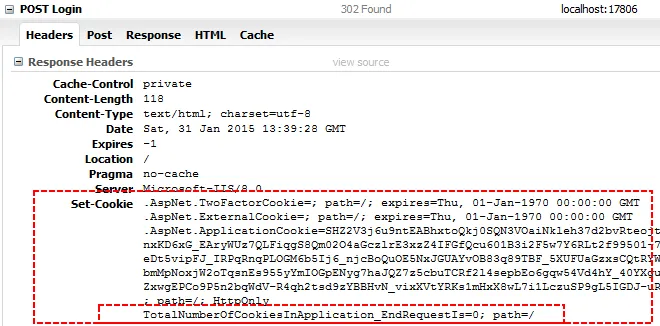作为一项测试,我使用Visual Studio 2013中最新的模板创建了一个全新的Asp.Net MVC5应用程序。我在Global.asax.cs中添加了以下方法:
当我启动应用程序并使用已注册用户的凭据进行POST到/Account/Login时,返回给客户端的cookie为:
(如果您感兴趣,我的动机是:我正在尝试修改auth cookies的域为“.abc.com”,其中“abc.com”是请求URI中主机的最后两部分。我希望这样做可以支持多个子域的身份验证。在全局Owin配置(IAppBuilder)上下文中设置CookieDomain并不足够,因为我们的调试/暂存/生产环境之间请求主机会发生变化,我们经常先将生产代码部署到Azure暂存进行测试,然后再进行VIP交换。)
(还要注意,我知道像这篇文章这样的文章,但它并没有解释cookie实际上是在哪里设置的)
编辑:
基于更多的搜索,似乎我正在研究错误的管道。Owin有自己的管道,所以我找到了this post,它描述了我们如何钩入它。嘿...那里就有了cookie。如果有人能确认这确实是最明智的方法,那就太好了。
编辑2:
最终决定查看Katana源代码,并发现我需要做的就是在我的CookieAuthenticationProvider中添加以下代码来设置我的cookie域。
希望这能帮助到遇到相同问题的人。
protected void Application_PreSendRequestHeaders()
{
Response.AppendCookie(new HttpCookie("TotalNumberOfCookiesInApplication_EndRequestIs", Response.Cookies.Count + string.Empty));
}
当我启动应用程序并使用已注册用户的凭据进行POST到/Account/Login时,返回给客户端的cookie为:

(如果您感兴趣,我的动机是:我正在尝试修改auth cookies的域为“.abc.com”,其中“abc.com”是请求URI中主机的最后两部分。我希望这样做可以支持多个子域的身份验证。在全局Owin配置(IAppBuilder)上下文中设置CookieDomain并不足够,因为我们的调试/暂存/生产环境之间请求主机会发生变化,我们经常先将生产代码部署到Azure暂存进行测试,然后再进行VIP交换。)
(还要注意,我知道像这篇文章这样的文章,但它并没有解释cookie实际上是在哪里设置的)
编辑:
基于更多的搜索,似乎我正在研究错误的管道。Owin有自己的管道,所以我找到了this post,它描述了我们如何钩入它。嘿...那里就有了cookie。如果有人能确认这确实是最明智的方法,那就太好了。
编辑2:
最终决定查看Katana源代码,并发现我需要做的就是在我的CookieAuthenticationProvider中添加以下代码来设置我的cookie域。
OnResponseSignIn = context =>
{
// Example only!
context.CookieOptions.Domain = context.Request.Uri.Host;
},
OnResponseSignOut = context =>
{
// Example only!
context.CookieOptions.Domain = context.Request.Uri.Host;
}
编辑3:
对于我的情况,更加简洁的解决方案是使用自定义cookie管理器,该管理器根据当前请求URI设置cookie域:
/// <summary>
/// This class simply appends the cookie domain to the usual auth cookies
/// </summary>
public class ChunkingCookieManagerWithSubdomains : ICookieManager
{
private readonly ChunkingCookieManager _chunkingCookieManager;
public ChunkingCookieManagerWithSubdomains()
{
_chunkingCookieManager = new ChunkingCookieManager();
}
public string GetRequestCookie(IOwinContext context, string key)
{
return _chunkingCookieManager.GetRequestCookie(context, key);
}
public void AppendResponseCookie(IOwinContext context, string key, string value, CookieOptions options)
{
// Simplification (use the context parameter to get the required request info)
options.Domain = ".domainBasedOnRequestInContext.com";
_chunkingCookieManager.AppendResponseCookie(context, key, value, options);
}
public void DeleteCookie(IOwinContext context, string key, CookieOptions options)
{
// Simplification (use the context parameter to get the required request info)
options.Domain = ".domainBasedOnRequestInContext.com";
_chunkingCookieManager.DeleteCookie(context, key, options);
}
}
然后将其设置在 Owin 设置中的 Cookie Auth 选项中:
app.UseCookieAuthentication(new CookieAuthenticationOptions
{
...
CookieManager = new ChunkingCookieManagerWithSubdomains(),
...
}
});
希望这能帮助到遇到相同问题的人。